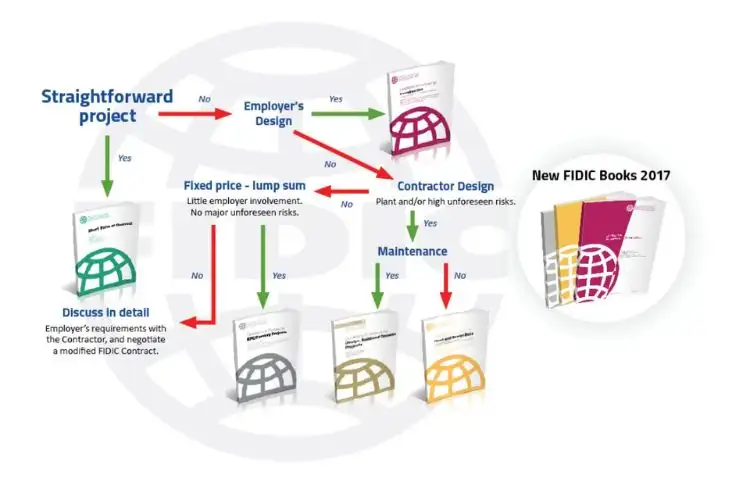What is a FIDIC contract? Latest FIDIC Contract Classification. How to choose the right type of FIDIC contract? Let’s find out about these issues through the following article.
1. What is a FIDIC contract?
FIDIC (Fédération Internationale des Ingénieurs – Conseils) is a contract drafted by the International Association of Consulting Engineers. It is a professional social organization of consulting engineers worldwide founded in 1913.
FIDIC contracts are used for large-scale international investment projects, where the parties involved in the project may have different nationalities, languages and come from different jurisdictions.
2. Latest FIDIC Contract Classification
Currently, the FIDIC contract template is distinguished by different colors as follows:
The commonly used FIDIC contract templates are classified as follows:
Green Roll: For low-cost or fast, easily accessible projects
Red Book: For classic projects designed by the Investor
Pink Book: For classic projects designed by the Investor but financed by development banks
Yellow Book: For Classic Projects Designed by the Contractor
Orange Book: For design-build and turnkey projects.
Silver Roll: For Turnkey/EPC Project
Blue Book: For Projects Involving Dredging, Renovation and Ancillary Construction
White Book: For appointing a consultant to provide services to the investor

3. How to choose the right type of FIDIC contract?
The selection of suitable samples depends on the type of project, specifically as follows:
3.1. Green Roll: For low-cost or fast, easily accessible projects
This model is selected for use when the construction or technique of the project is of small value or construction is carried out in a short time. This form can be applied to contracts with a value of less than 500,000 USD or a construction period of less than 6 months. The Green Roll is also said to be suitable for simple or repetitive tasks.
Normally, for this model, the Contractor is required to construct the work in accordance with the design without paying attention to the design provided by the Investor or the Contractor.
When using this contract form, there will be no monthly payment or monthly assessment.
3.2. Red Book: For classic projects designed by the Investor (Construction Contract)
The Red Book is recommended to be used for construction contracts or technical works where the investor is almost entirely responsible for the design part. In fact, the Red Scroll is most used for construction contracts worldwide in case most of the work is designed by the developer.
The Red Book is a payment made in accordance with the weight schedule although the payment can be made on a package basis for work items.
The Red Book will be managed by engineers instead of Contractors and Investors. The engineer will be responsible for supervising the construction of the work and confirming the payment.
3.3. Pink Book: For classic projects designed by the Investor but financed by development banks
The Pink Book is considered a derivative work of the Red Book. The Pink Book was drafted for use in projects financed by development banks, such as the World Bank, when the Red Book could have been used in a different way.
Note that when the project is funded by the World Bank and the investor is not responsible for the design, the Pink Roll will not be used.
3.4. Yellow Book: For classic projects designed by the Contractor (Design – Construction Contract)
This contract is recommended to be used for projects where the Contractor performs the majority of the design work. Yellow Notebook is often used for construction and engineering projects/works.
The Yellow Book is a type of package contract with payments made if important completion milestones are achieved based on the engineer’s certification. Therefore, the Contractor is dependent on
on completing obligations according to the schedule to complete the project.
3.5. Orange Book: For design – construction and turnkey projects
The contractor must be responsible for almost the entire implementation.
The consultant in this contract will have the role of managing the contract, supervising the erection and production work at the construction site or construction works, and establishing the payment.
3.6. Silver Scroll: For turnkey/EPC projects
Silver Roll is used for use in EPC Projects. These are projects that require the Contractor to design and implement the project to provide full utilities for the Investor and these utilities are ready to operate at the time of unlocking, requiring the Contractor to take higher responsibility for the design and construction of the Project.
When using this template for price details, the completion date is considered a top priority. It allows the Employer to have a cost advantage over the Contractor when they have to bear more cost and time risks than the Yellow Book.
Silver rolls are also used for separately funded projects – projects where the investor is responsible for the design, construction, warranty and operation of the project and will transfer the responsibility for construction to the investor.
3.7. Blue Book: For projects related to dredging, renovation and auxiliary construction work
The Blue Roll is suitable for all types of dredging and renovation work as well as auxiliary construction work.
Usually, used to adjust for contracts that have the entire design work of the Contractor.
3.8. White Book: used to appoint a Consultant to provide services to the Employer
This template is not suitable for construction and job design jobs. This form is used to appoint a consultant to provide services to the Investor such as feasibility study, design, management contract, and project administration.
It is usually possible to build an agreement between the parties who are the Consultant and the Investor that when the construction and design are carried out, it will be in accordance with a certain FIDIC contract.





